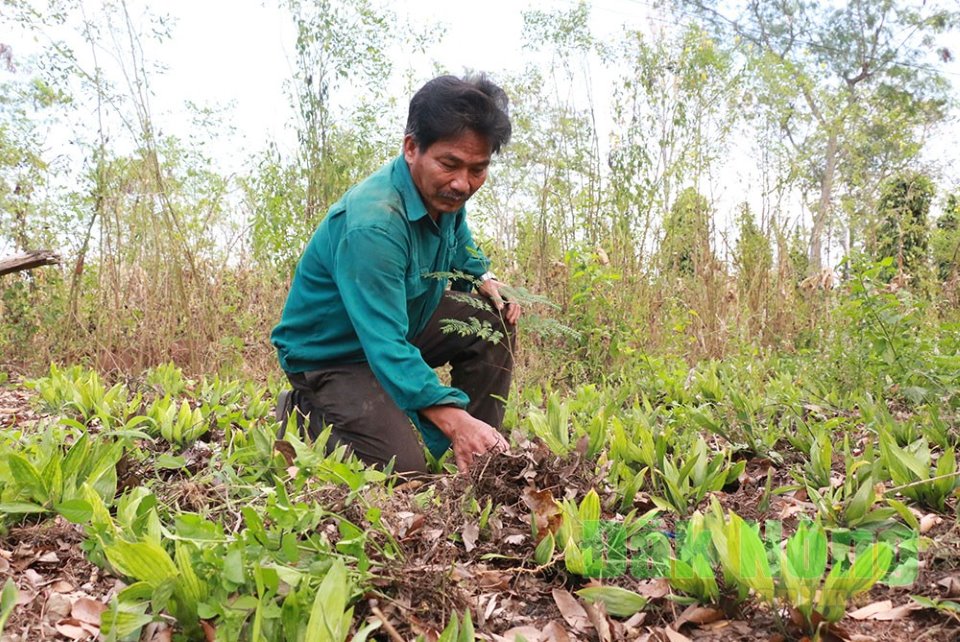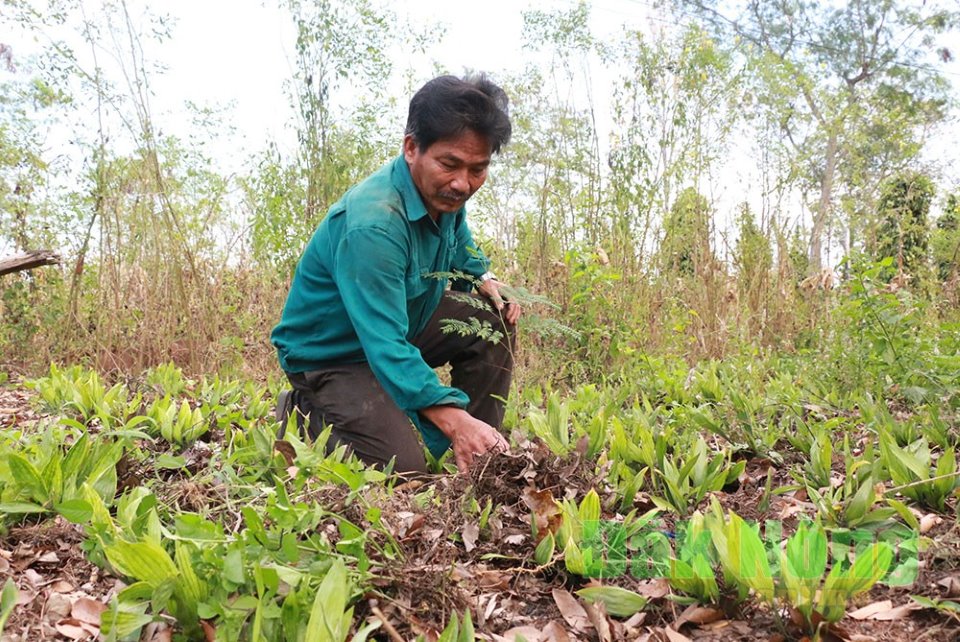
By pivoting on available potentials and advantages, a number of farmers in Krong No district (Dak Nong) have started to attach importance to preserving and developing valuable medicinal herbs, raising the efficacy of land use, the income and create livelihood for local people. However, in comparison with the present local potentials and advantages, medicinal herbs in general have yet to be adequately developed in both terms of scale, varieties and economic benefit.

The pilot model for growing Curculigo orchioides (Sâm Cau in Vietnamese) of Mr Dat's household in Duc Lap
hamlet, Dak Sor commune (Krong No)
Krong No district is located within the hot and wet climate zone and divided into 2 distinct season of rainy and dry season, which is very favorable for the development of medicinal herbs. Having been conscious of such advantages, over the last year, many farmers in Krong No district have attached importance to developing kinds of medicinal herbs under the foliage of the forests and other industrial plants.
As the statistics of the specialized agencies show, the area of land cultivated with medicinal herbs in Krong No district is presently estimated at about 128 ha, the main varieties of which include: Polyscias fruticosa, tumeric, ginger, gac ( Momordica cochinchinensis), lemongrass, Coix lacryma-jobi, etc. After a number of year of growing and nuturing, medicinal herbs are now thriving in good conditions, bringing about high economic value, and giving local people more options in deciding which kind of plants to grow to raise the efficiency over each unit of cultivated area.
In fact, the development state of medicinal herbs has still been inadequate given the local potentials and advantages. That is to say, the growing scale is still moderate in size and sparsely distributed along with the saling markets having not been stable yet. Also, Dak Nong province has yet to develop the planning for the processing and specialized zone of medicinal herbs. In response to such situation, Krong No district has taken the initative to build up its own planning for developing medicinal herbs, aiming to solidly exploit the economic efficacy of this resource.
At present, Krong No district has 11 out of 12 communes and town having invested in building and growing the modeling gardens of medicinal herbs, with over 40 different varieties in the listing of the Ministry of Health having been grown. Those modeling gardens grow, at the same time, introduce the uses of medicinal herbs aiming to encourage the communities to multiply the modellings, and disseminate the instructions on how to use medicinal herbs to cure some common diseases.
Aside from developing the concentrated material zone, the district has also been calling for businesses, companies, organizations and individuals to invest in the building the chain of producing and saling medicinal herbs. In addition, the funtional agencies have been giving instructions to local people on the techniques for growing, nuturing and harvesting medicinal herbs, disseminating related knowledge to raise people's perspective on medicinal herbs. To guarantee the long lasting and sustainable development of this resource, the local authorities have also agitated local people not only to exploit but also preserve medicinal herbs at the same time, especially to avoid the turbulent exploitation, which might send medicinal herbs into the danger of extinction.
In 2017, the district developed a model for preserving the gene supplies of Curculigo orchioides (Sâm Cau in Vietnamese) in Dak Sor commune over an area of 300 square meters. In 2018, Krong No disrict's Division of Agriculture have planned to cooperate with the local households to develop a value chain model of Polyscias fruticosa (Đinh lăng in Vietnamese) with the scale of 5 ha and total original investment of over VND1.2 billion, of which, the State's investment accounts for VND600 million while the remaining proportion is farmer's investment.
The authority of Krong No district disclosed that the district has already developed a plan with concrete objectives on developing medicinal herbs in a way that is correspondent to the district's potentials. In the short term, the district would keep maintaining and nuturing about 50 ha of some medicinal herbs such as Polyscias fruticosa, tumeric, and ginger.
In the future, Krong No district would strive for the goal of developing about 200 ha of medicinal herbs, recovering and preserving a number of rare medicinal herbs like Curculigo orchioides, Longjack, Phyllanthus niruri. Besides, the district will develop from 3 to 5 livelihood models under the forests' foliage, grow some varieties of plants such as Scaphium macropodum (Ươi in Vietnamese), Styphnolobium japonicum (Hòe in Vietnamese), Moringa oleifera (Chùm ngây in Vietnamese) to increase the covering.
By 2025, the whole district would have stably developed 500 ha of land cultivated with a variety of medicinal herbs, largely concentrated in such communes as Dak Sor, Nam Xuan, Tan Thanh, Dak Dro, Nam N'dỉ, Quang Phu...with a view to developing medicinal herbs into economically valuable commodities.
According to www.baodaknong.org.vn